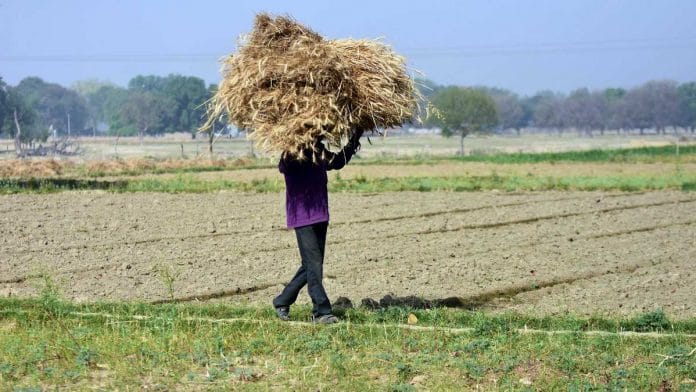Gurugram: Haryana witnessed a sharp ‘reverse migration’ soon after the Covid-19 pandemic hit, with many people moving back to the agriculture sector for work, far outpacing other agrarian states, according to a new report by the National Bank for Agriculture and Rural Development (NABARD).
According to NABARD’s All India Rural Financial Inclusion Survey 2021-22, the percentage of agricultural households in Haryana shot up from 34 percent to 58 percent in the five years up to 2021-22, marking a 24 percentage point increase.
The increase was not so sharp in other states.
The number of agricultural households in Uttar Pradesh, for instance, increased from 63 percent to 66 percent; in Chhattisgarh from 55 to 66 percent; in Rajasthan from 63 to 66 percent; in Madhya Pradesh from 58 to 66 percent; in Odisha from 58 to 60 percent; in Uttarakhand from 41 to 57 percent; and Telangana from 47 to 55 percent.
In contrast, states like Gujarat, Karnataka, Bihar and Punjab saw a decline in the number of households dependent on agriculture in 2021-22 compared to 2016-17.
Gujarat, for instance, saw a 4 percentage point decrease in the share of agricultural households from 58 percent to 54 percent. Karnataka saw it fall from 59 percent to 55 percent, Bihar from 47 percent to 45 percent, and Punjab from 42 percent to 36 percent.
Overall, though, the share of agricultural households across the country went up—from 48 percent to 57 percent.
Experts say the disparity underscores Haryana’s struggle to create job opportunities outside the agricultural sector.
“The sharp increase in agricultural households in Haryana over five years suggests that the state hasn’t been able to provide employment opportunities in other areas,” said Devinder Sharma, a food and agriculture policy expert.
“These other states have managed to generate jobs in urban sectors and industries, reducing reliance on agriculture for livelihoods,” he said.
Haryana’s lack of diversification in employment
While Haryana has focused on industrial and infrastructural development, the lack of diversification in employment is evident. The rise in rural households returning to agriculture often reflects economic stress, as individuals resort to traditional livelihoods when non-agricultural avenues falter.
This trend also indicates an economic paradox. Despite Haryana being one of the leading states in GDP growth and industrial output, the benefits have yet to translate into adequate job creation across non-agricultural sectors.
The state’s rural employment patterns reveal an urgent need for targeted policies to stimulate non-farm activities, skill development, and investments in industries and services to address the high unemployment rate.
Agricultural experts say the rise in agriculture-dependent households suggests that employment in other sectors, such as manufacturing, construction, and services, has not kept pace with the growing workforce.
In December 2022, the Centre for Monitoring the Indian Economy (CMIE) put Haryana’s unemployment rate at 37.3 percent.
In a reply in the Rajya Sabha on 10 August, 2023, the government put the unemployment rate in Haryana at 2.8 percent for illiterates, 2.9 percent for primary education level, 9.9 percent for the middle pass, 6.5 percent for the secondary level, 13.7 percent for senior secondary level, 20.1 percent for diploma holders and 18.4 percent for graduates, all above the age of 15 years.
Sharma said Haryana’s case is “appalling” because such a large percentage of households had returned to agriculture knowing well that there is not much opportunity available. He added that the dependence on agriculture can create its own sustainable pathways, provided the government invests adequate resources in the sector.
To achieve this, economists must move away from viewing any proposed increase in agricultural budgetary allocation solely as a burden on the fiscal deficit, Sharma said.
Mahabir Jaglan, a retired professor from Kurukshetra University, however, said that the increase in the share of agricultural households in India and most of the states was a result of multiple factors that varied from state to state.
“Firstly, demonetisation in 2016 destroyed the informal sector of the economy, particularly small businesses that employed a large number of people,” Jaglan said.
“Secondly, Covid-19 led to the closing down of industries and businesses but it had no impact on agriculture. Because of these two factors, rural workers came back and started working in the agricultural sector. So naturally the percentage of agriculture-dependent households increased abruptly.”
He said migrants from Punjab didn’t return during the pandemic because most are international workers, primarily in Canada, the US and Europe. As a result, the state’s dependence on agriculture continued to decline because its migrant workers were not hit by demonetisation and the pandemic.
Jaglan further explained that workers from Haryana didn’t return to the informal sector and industry because of a sharp decline in employment opportunities after demonetisation and COVID-19. Additionally, wage rates in these sectors also decreased as unemployed workers accepted lower wages.
As a result, many workers who returned to agriculture during the pandemic remained there as they saw no opportunities in other sectors.
“Unfortunately, the Haryana government failed to create employment opportunities outside of agriculture, leading to the dependence of households on agriculture in the state,” Jaglan said.
(Edited by Zinnia Ray Chaudhuri)






